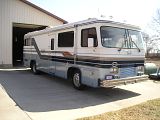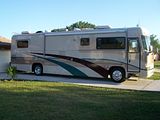Go to...  | Start A New Topic  | Search  | Notify  | Tools  | Reply To This Topic  |  |
 10/10 10/10 |
Hello, I'm looking at a 1993 36' Barth that has a 250 hp 8.3 liter Cummins "C" series engine. It is pretty sluggish off the line so I'm wondering if boosting it up to 300 hp will make a big difference or will it just use a lot more fuel with little gain in performance? Thanks in advance. Roman 1993, 34', Regency, Widebody 300 HP Cummins 6 spd Allison, Spartan Chassis | ||
|
Check with a good turbo guy, there are mods, smaller hot section that will get it to spool faster and will greatly help the off line performance and will not hurt the cruise economy. I have the same problem with my B5.9 and will change out the turbo at some time in the future. I changed the air routing from the intercooler to the engine intake manifold and that really made a difference but I don't think it would be the same issue with the 8.3. For reference you have a much higher gross weight then I do and you only have 20 more HP then I. 8.3 are easily modified to over 300 hp and those mods shouldn't hurt the economy either if you watch the cruise speed. My MPH drops quickly after 65 MPH. Ed 94 30' Breakaway #3864 30-BS-6B side entry New Cummins 5.9L, 375+ HP Allison 6 speed Spartan chassis K9DVC Tankless water heater | ||||
|
FKA: noble97monarch 3/12 3/12 |
Check with Banks Turbo, they make much higher boost turbo kits that are the standard for Cummins power upgrades. Corey  Formerly: 1997 Barth Monarch Now: 2000 BlueBird Wanderlodge 43' LXi Millennium Edition DD Series 60 500HP 3 stage Jake, Overbuilt bike lift with R1200GS BMW, followed by 2011 Jeep Wrangler Unlimited, “I haven’t been everywhere, but it’s on my list.” | |||
|
Sluggish off the line may be no boost until the engine starts working. Our Newell is a turtle off the line, just waiting for the turbo to spin up. The Barth I have to feather foot it until the boost builds up. So the question is how does it perform once it is moving? Also get a boost gauge so you can see what is happening. If you boost the performance you need to get an exhaust gas temperature gauge. '92 Barth Breakaway - 30' 5.9 Cummins (6B) 300+ HP 2000 Allison Front entrance | ||||
|
FKA: noble97monarch 3/12 3/12 |
There's an old adage in the hot rodding community that states "There's no replacement for displacement". Throughout the last several centuries, man has tried to get more for less when it comes to power generation from internal combustion engines. One of the most successful ways has been the Turbo-charger which simply takes the spent power of the exhaust and converts it to "forced" induction. Forcing more air into the intake, versus what would naturally be sucked in, is a guaranteed performance booster. The big problem with turbos is they always have "turbo lag" due to the need for engine RPMs to create the boost. Sort of a catch 22, you need power to make more power. This is why you feel your turbocharged diesel start sluggishly off the line, then a little kick in the pants, then a lot of kick - just then it shifts gears and you start over again. One can see, the transmission plays a big role in how usable the turbocharged engine is in practical use. Some people refer to turbos as a "blower", but I'm from the old school that thinks of a blower as a Roots Type Compressor. These were commonly found on the earlier two stroke diesels and force induct through compression vanes driven directly off the motor. They have much better acceleration as the compression was immediate, but were expensive, heavy, and not as efficient. Although not recommended, another way to boost a diesel is through Propane Injection, the sister to Nitrous Oxide on gasoline engines. This creates instant power at all RPMs by adding more oxygen chemically instead of through forced induction. I think the worry is that the motor may not take well to this instant power and blow something up. Ok, so you might ask how they get so much horsepower these days out of same size motors? Answer, increased efficiency through computers and design. Conclusion: Get a bigger turbo, a bigger motor, or lighten your Barth by filling it with helium when traveling!! LOL Corey  Formerly: 1997 Barth Monarch Now: 2000 BlueBird Wanderlodge 43' LXi Millennium Edition DD Series 60 500HP 3 stage Jake, Overbuilt bike lift with R1200GS BMW, followed by 2011 Jeep Wrangler Unlimited, “I haven’t been everywhere, but it’s on my list.” | |||
|
 10/10 10/10 |
Thanks to all for the tips and insight to my performance questions. It's clear that I have a lot to learn about motorhome performance or lack there of as the case may be. Thanks again. Roman 1993, 34', Regency, Widebody 300 HP Cummins 6 spd Allison, Spartan Chassis | |||
|
 4/11 4/11 |
It helps if you stop on a down slope rather than on the upside of a hill. If I need to pull over on the side I usually look for the down slope so that when I need to pull back into traffic I don't need to fight gravity also. Sounds too simple but it really works. Tom Loughney Barthless.... | |||
|
 1/09 1/09 |
too much of a increase in the h.p. could decrease engine life.. | |||
|
FKA: noble97monarch 3/12 3/12 |
Speaking of Horsepower, I watched the Space shuttle take off last night and once again it was a religious and patriotic experience. Even the mission control people said it was the prettiest launch ever as it left Earth at 7:45 with the exhaust plume capturing all the colors of the sunset. When thinking of power, we often look at Horsepower, but it is really Torque that gives an engine its usable power. If I remember correctly, horsepower is calculated by multiplying the torque by RPMs at the most efficient point on the torque curve. Diesels are generally low reving engines, versus gas, so they need to produce much more power at low RPMs to get the same HP rating. A Top Fuel Dragster, for instance, can produce around 8500HP, but only for seconds at very high RPM. Back to the Space Shuttle, try 37 million horsepower!!! Here's some fun facts - The energy released by three of Rocketdyne's Space Shuttle Main Engines is equivalent to the output of 37 Hoover Dams. Although not much larger than an automobile engine, the SSME high-pressure fuel turbopump generates 100 horsepower for each pound of its weight, while an automobile engine generates about one-half horsepower for each pound of its weight. Even though Rocketdyne's SSME weighs one-seventh as much as a locomotive engine, its high-pressure fuel pump alone delivers as much horsepower as 28 locomotives, while its high-pressure oxidizer pump delivers the equivalent horsepower for 11 more. If water, instead of fuel, were pumped by the three Space Shuttle Main Engines, an average family-sized swimming pool could be drained in 25 seconds. Cool huh? Corey  Formerly: 1997 Barth Monarch Now: 2000 BlueBird Wanderlodge 43' LXi Millennium Edition DD Series 60 500HP 3 stage Jake, Overbuilt bike lift with R1200GS BMW, followed by 2011 Jeep Wrangler Unlimited, “I haven’t been everywhere, but it’s on my list.” | |||
|
Glassnose Aficionado |
We saw the shuttle launch from Venice and it was incredible. We could see the separation of the engines and how long it takes for main tank separation [on TV]. Very cool. 79 Barth Classic | |||
|
| Powered by Social Strata |
| Please Wait. Your request is being processed... |
|
This website is dedicated to the Barth Custom Coach, their owners and those who admire this American made, quality crafted, motor coach.
We are committed to the history, preservation and restoration of the Barth Custom Coach.
We are committed to the history, preservation and restoration of the Barth Custom Coach.

